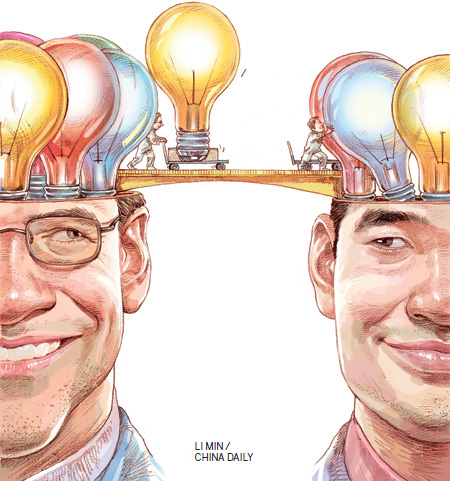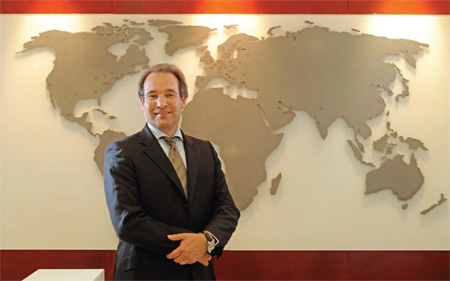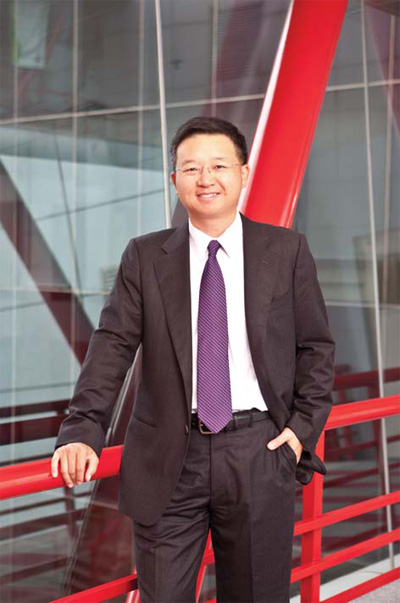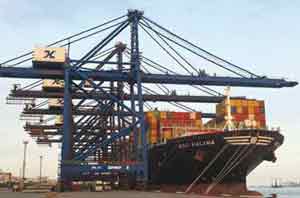Research in motion
Updated: 2011-11-11 09:02
By Andrew Moody (China Daily)
|
|||||||||

Multinationals moving R&D centers to China
Chuang Ching may be a head of research and development for a company that invented the telephone but it is China where he now wants to be.
|
||||
The company is one of an increasing number of foreign multinationals that have a major research and development hub in China.
According to China's Ministry of Commerce figures, there are now 1,200 foreign multinational R&D centers in China, representing a $12.8 billion (9.3 billion euros) investment. There are no fewer than 353 such centers in Shanghai alone.
Chuang, executive vice-president of product and research and development of Alcatel-Lucent Shanghai Bell, says China was at the forefront of the company's research and development efforts.
"China has a rich talent pool and our workforce is very young, dynamic, highly motivated and able to meet challenging targets," he says.
Foreign multinationals increasingly see China as the land of invention.
The once technologically backward country - that shunned science for 200 years until the last century - is now a magnet as one of the world's major R&D centers.
Since 2002 expenditure by foreign companies in research in China has increased by 21.2 percent annually.
According to a forecast by Battelle magazine, China is set to overtake Japan as the second-largest spender on R&D this year with total expenditure of $153.7 billion compared to its neighbor's $144.1 billion. It still trails well behind the United States, which spends $405.3 billion.
The attractions of the world's second-largest economy as an R&D center may be obvious. There is a plentiful supply of young and relatively inexpensive science graduates compared to the West.
China has one of the fastest growing and potentially biggest markets in the world so to be able to develop a product or service for that market could deliver major financial benefits.
The government is also keen to offer incentives for foreign companies to set up R&D bases in the country as part of its 12th Five-Year Plan (2011-2015).
Chuang, who is from Taiwan and educated in the United States at the University of Southern California, says government support is attractive to multinationals.
"The government's Five-Year Plan is focused on innovation and a very important part of that is incentives to encourage research and development investment not just for domestic but for multinational companies too, relating to costs and business tax incentives to set up research and development centers."
While there are many upsides to having a research and development base in China, for some companies there is one big risk - intellectual property theft. Many companies are nervous about bringing their core blue-sky research to China. That, they feel, is best kept under lock and key at their corporate headquarters in the West.
Many cite the problem as enforcement rather than Chinese law. Even the very simple process of applying for a patent in China can expose any innovation to the risk of being copied.
"You can put a patent out and it is copied straight away," says a leading business adviser in China who didn't want to be named.
"I have even seen cases of Chinese companies seeing what a competitor has developed and then patenting it themselves, enabling them to sue the competitor who invented the particular thing in the first place for patent infringement. There have been a number of Chinese companies fighting each other like that."
Franz Greidanus, head of Dutch electronic and consumer goods conglomerate Philips Research Asia, based in Shanghai, is a seasoned veteran of the China R&D scene having been in the country for six years.
He says there could be big IP risks for some companies doing business in China.
"If you had a small company with one product which had a lot of trade secrets, then it would be extremely dangerous to start producing that in China so it depends on the type of business you are in," he says.
Bernhard Hartmann, managing director of international management consultants AT Kearney in China who is based in Shanghai, says when he gives a presentation to a global board of a company he always give the same advice in relation to IP.
"What I would recommend to a client is for them to have one lab in the US, one in Europe and one in China but that they should not work on their most revolutionary topics in China. It is just a down to earth recommendation that I have," he says.
Chuang from Alcatel-Lucent Shanghai Bell was on a visit to the company's research and development base at the Wangjing Science and Technology Park in Beijing.
The company itself is a product of a number of mergers but owes its origins back to Alexander Graham Bell who invented the telephone in the 19th century when China was very much in a technological dark age.
It employs no fewer than 5,200 engineers at research bases throughout China, 35 percent of who are under 30 and 96 percent under 40. The average age is 32.
"The average age is low-30s compared with our research and development centers outside of China where it is low-40s or mid-40s. It doesnt mean, however, it will take 10 years to catch up with that experience since we can do it quicker through project participation."
Chuang says one of the key advantages of being in China is proximity to the production process to develop products for the local market.
"We can be close to our manufacturing facilities and supply chains so the results of our research and development can go straight into manufacturing without having to go back and forth between here and the United States."
Hartmann at AT Kearney in China, who has a close knowledge of research in the chemicals sector, says foreign multinationals setting up R&D centers in China has become a big trend.
"You have companies like Bayer investing massively and building a research and development center in Shanghai, you have Merck opening a big lab in Beijing, so too AkzoNobel. Instead of companies having no real R&D here five or 10 years ago, now they have 10 to 15 percent of their worldwide spend here.
"What is happening with the big global companies is that instead of having their Asia lab in Singapore they now want to have it in Shanghai."
One company that has invested heavily in R&D in China is GE.
It has had research facilities in China since 2000 and now has 1,500 of it global 2,800 research staff here.
Since 2008 it has invested a major chunk of its R&D investment in the country and has delivered up to 30 successful projects every year.
Far from keeping its blue-sky research back in its US headquarters, 200 of its staff in China are part of the company's core research team.
"We selectively develop in China since compared to our 110-year-old center in New York we are relatively young," says Chen Xiangli, president of the GE Technology Center in China.
"We focus on a few areas where we can make an impact and where we could become global leaders quickly."
Chen, who was also partly educated in the US at the University of Illinois at Urbana-Champaign, joined GE in New York in 1994.
He has held his current position since 2007 and has won a major award from the Shanghai municipal government for his contribution to R&D.
He says the company's focus on R&D is not primarily motivated by cheaper labor.
"Not very long ago when I started here, labor rates were a fifth of those in the United States. Now they are 40 percent. I am sure that in five or 10 years time they will be pretty equal," he says.
"The key for us is to be closer to the market and to have more innovation capability in this part of the world. Being close to the customer really is a main driver."
Greidanus at Philips says the very fact that more foreign multinationals are setting up research bases in the country is driving up the cost of labor.
"The competition in the labor market has become severe because you not only have more multinational but Chinese companies trying to attract the same talent. The cost of living in Shanghai and Beijing, where most of the centers are, also means the cost of labor goes up," he says.
"This shouldn't be a major consideration because you wouldn't start a research laboratory somewhere because the labor cost was low."
Philips has 1,800 research and development staff in China, 1,200 of who are in the Shanghai area. Around 110 are key staff working on high-level research.
The company has developed a number of products with the China market in mind. One is a kitchen appliance that washes fruit and vegetables and is set to do well when it is launched because it addresses local concerns about pesticide contamination.
Another is an air purifier for use inside cars by drivers and passengers worried about the air they breathe among all the pollution.
"We have had some success working in these domains and we expect more in the next few years," adds Greidanus.
Some believe that the multinationals working on research in China have the potential to create a fusion which can drive technological development.
Arding Hsu, senior vice-president of German electronics and engineering company Siemens, which has major R&D facilities in China, is one who believes this to be the case.
"China is an ideal place for fusion innovation to thrive. On the one hand, China's fast-growing market is characterized by massive and diverse needs.
"On the other hand, the long history and brilliant culture of this country have accumulated a lot of interesting knowledge."
Greidanus feels there needs to be more fusion, as foreign multinationals are still excluded from a number of the government-led R&D programs, where he believes they could play a major role.
"It has been traditionally difficult for multinationals in China to participate in these programs but we hope that will change over time," he says.
"We have had several indications in terms of the discussions that we have had with the government where we could at least submit a proposal. So we have seen some progress there."
Whether foreign multinational will ever be fully part of a national R&D strategy remains doubtful.
For the moment they are playing a key role in developing the country's R&D base with many of the Chinese scientists they foster going on to work for Chinese companies.
Chen at GE does not necessarily see this as a bad thing so long as they don't take with them company secrets.
"When you lose 5 to 10 percent a year of your population you are bound to have some people walk away with the know-how. I don't see it different from anywhere else. It is just the same for us in the US."
|
Bernhard Hartmann of AT Kearney says multinationals setting up R&D centers in China has become a big trend. Gao Erqiang / China Daily |
|
Arding Hsu, senior vice-president of Siemens, says China is an ideal place for fusion innovation to thrive. Provided to China Daily |
|
Chuang Ching of Alcatel-Lucent Shanghai Bell says government support to R&D investment is attractive for multinationals. Liu Zhe / China Daily |
|
Chen Xiangli, president of the GE Technology Center in China, says being close to customers is the main draw for multinationals' R&D investment in the country. Provided to China Daily |



















